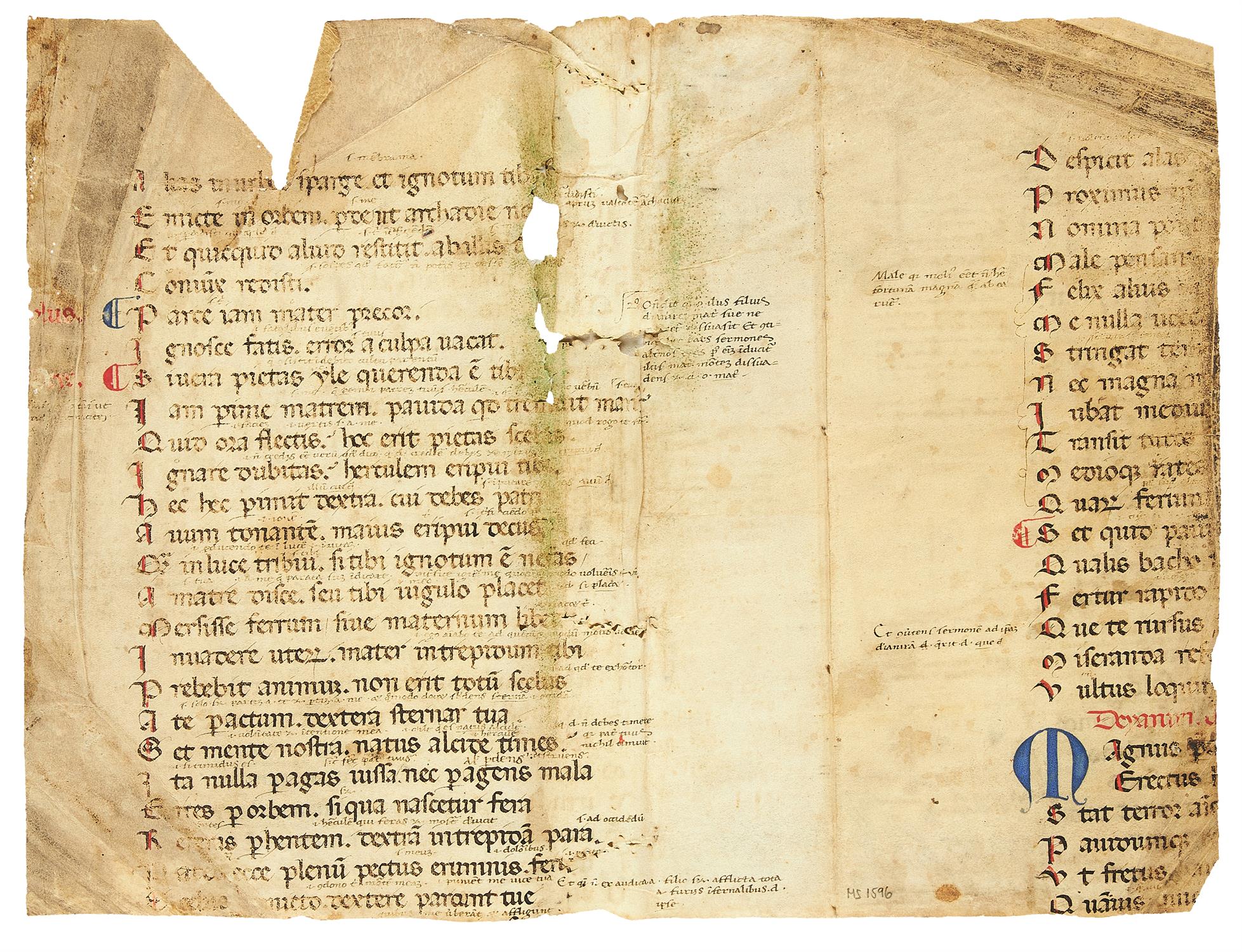Leaf from Seneca the younger, Epistulae Morales ad Lucilium, in fine humanist script, in Latin, illuminated manuscript on parchment [Italy (perhaps Rome), c. 1470] Single leaf, with single column of 28 lines of a bold and round humanist minuscule, rubrics in faded red with last letters of final word in capitals spaced out to fill up line, contemporary '71' in margin next to initial, one large illuminated initial 'P' (opening 'Post longum intervallum pompeyos ...', the opening of epistle 71, modern 70), on blue, green and burgundy grounds heightened with clusters of 3 white dots, and with white vine foliage picked out in penwork and blank parchment, extensions into margin in same filling approximately half the vertical margin, some near-contemporary marginalia, one contemporary flaw in parchment, small spots and stains, trimmed at edges, overall excellent and bright condition, 286 by 205mm. Provenance: 1. From a remarkably fine humanist manuscript of grand dimensions, produced in Italy c. 1470. Certain features, such as the 'the very careful slowly-written rather consciously classical script' as noted by Sotheby's (see below), and the ruling in plummet and proportions of the illuminated initial in the Schøyen leaf (see below) might suggest that the scribe was Germanic, perhaps among those resident in Rome. 2. Neil F. Phillips, Q.C. (1924-97) of Montreal, New York, and Virginia (together his MS. 811); his sale Sotheby's, 2 December 1997, lot 67, as one of two leaves from this manuscript. 3. Maggs Bros., European Bulletin 22 (1998), no. 81 (illustrated in colour there). 4. Private North American collector, perhaps in Logan, Utah (and framed there c. 2000 for that owner). 5. PBA Galleries, San Francisco, 13 September 2012, no. 118, acquired there by Roger Martin Text: Unlike many other works of Classical literature, the Middle Ages never set aside and forgot the gentle moralising works of the Roman philosopher and statesman, Seneca the younger (c. 4 BC.-65 AD., more properly Lucius Annaeus Seneca). The letters here cover the subjects of rest and restlessness, on the time in life we enter a life of relative relaxation and comfort (using a ship finding harbour as its metaphor), and on the supreme good. Apart from this one, five other leaves from this impressive manuscript are known: (1) Keio University (Keio, PTP, 92), most probably the sister leaf of this one, once in the Phillips' collection and acquired by Keio from Maggs; (2) that in Quaritch, cat. 1088, Bookhands of the Middle Ages III, no. 89 (with full-page illustration); (3) Quaritch, cat. 1147, Bookhands of the Middle Ages V, no. 116, to Schøyen collection, MS 647, and his sale, Christie's, 10 July 2019, lot 457; (4) Quaritch, cat. 1270 (2000), no 122; and (5) Takamiya collection, MS. 84, now Beinecke Library, Yale (see R. Clemens, et al., A Gathering of Medieval English Manuscripts: the Takamiya collection at the Beinecke Library, 2017, p. 82).
Leaf from Seneca the younger, Epistulae Morales ad Lucilium, in fine humanist script, in Latin, illuminated manuscript on parchment [Italy (perhaps Rome), c. 1470] Single leaf, with single column of 28 lines of a bold and round humanist minuscule, rubrics in faded red with last letters of final word in capitals spaced out to fill up line, contemporary '71' in margin next to initial, one large illuminated initial 'P' (opening 'Post longum intervallum pompeyos ...', the opening of epistle 71, modern 70), on blue, green and burgundy grounds heightened with clusters of 3 white dots, and with white vine foliage picked out in penwork and blank parchment, extensions into margin in same filling approximately half the vertical margin, some near-contemporary marginalia, one contemporary flaw in parchment, small spots and stains, trimmed at edges, overall excellent and bright condition, 286 by 205mm. Provenance: 1. From a remarkably fine humanist manuscript of grand dimensions, produced in Italy c. 1470. Certain features, such as the 'the very careful slowly-written rather consciously classical script' as noted by Sotheby's (see below), and the ruling in plummet and proportions of the illuminated initial in the Schøyen leaf (see below) might suggest that the scribe was Germanic, perhaps among those resident in Rome. 2. Neil F. Phillips, Q.C. (1924-97) of Montreal, New York, and Virginia (together his MS. 811); his sale Sotheby's, 2 December 1997, lot 67, as one of two leaves from this manuscript. 3. Maggs Bros., European Bulletin 22 (1998), no. 81 (illustrated in colour there). 4. Private North American collector, perhaps in Logan, Utah (and framed there c. 2000 for that owner). 5. PBA Galleries, San Francisco, 13 September 2012, no. 118, acquired there by Roger Martin Text: Unlike many other works of Classical literature, the Middle Ages never set aside and forgot the gentle moralising works of the Roman philosopher and statesman, Seneca the younger (c. 4 BC.-65 AD., more properly Lucius Annaeus Seneca). The letters here cover the subjects of rest and restlessness, on the time in life we enter a life of relative relaxation and comfort (using a ship finding harbour as its metaphor), and on the supreme good. Apart from this one, five other leaves from this impressive manuscript are known: (1) Keio University (Keio, PTP, 92), most probably the sister leaf of this one, once in the Phillips' collection and acquired by Keio from Maggs; (2) that in Quaritch, cat. 1088, Bookhands of the Middle Ages III, no. 89 (with full-page illustration); (3) Quaritch, cat. 1147, Bookhands of the Middle Ages V, no. 116, to Schøyen collection, MS 647, and his sale, Christie's, 10 July 2019, lot 457; (4) Quaritch, cat. 1270 (2000), no 122; and (5) Takamiya collection, MS. 84, now Beinecke Library, Yale (see R. Clemens, et al., A Gathering of Medieval English Manuscripts: the Takamiya collection at the Beinecke Library, 2017, p. 82).


.jpg?w=400)


.jpg)
.jpg)







Testen Sie LotSearch und seine Premium-Features 7 Tage - ohne Kosten!
Lassen Sie sich automatisch über neue Objekte in kommenden Auktionen benachrichtigen.
Suchauftrag anlegen